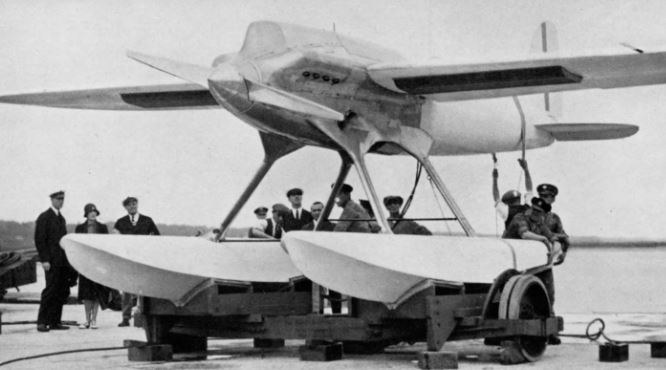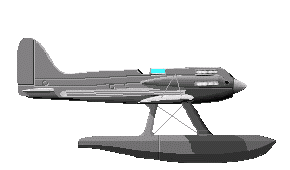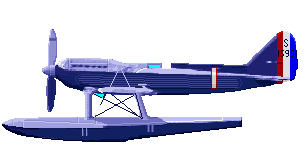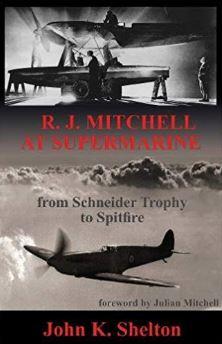Dinger's Aviation Pages
The Schneider seaplane contest.
The Schneider prize for seaplanes was first announced by Jaques Schneider, the French Under-Secretary for Air, in 1911, with a prize of the then huge amount of 1,000 pounds. It was meant to encourage progress in civil aviation but became a contest primarily about speed.
In the twenties, it was a spur to aircraft development and in the end, was seen as a test of nation`s strengths in aviation technology. It was largely due to the Schneider trophy that aircraft speeds rose from 150 mph at the end of the First World War, to over 400 mph in 1931. The race gave birth to the Spitfire and the Italian Macchi fighters and established the low drag liquid-cooled engine as the fast fighter designers principal choice for power. A fashion that only died with the success of the German FW 190 and the American Corsair and Thunderbolt.
Britain won the trophy in 1914. After the war, the first contest, in 1919, was declared void by the judges. In 1920 and 1921 the contest was won by the Italians. The rules said that any nation that won the trophy three years in succession could keep it. So it was a close-run thing when Britain`s Supermarine Sea Lion snatched victory by tactical flying in the 1922 race with a speed of 145mph.
The next year saw a technical revolution in the shape of the American Curtiss floatplanes with their in-line liquid-cooled engines. The Curtiss won with a speed of 177mph. Mr C.R. Fairey of the Fairey Aircraft Company was so impressed with the new engines, he purchased some and fitted them to a new light bomber, the Fairey Fox. The Fox was so fast that no RAF fighter could catch it. An example of how the race was prompting aircraft development.
The 1924 contest was declared void since no other nation turned up to challenge the Americans. In 1925 R.J. Mitchell`s Supermarine S4 was entered. The S4 was very advanced, a true cantilever monoplane with no external bracing of the wing. Before it went out to the USA to take part in the Schneider trophy it had already set a new World speed record of 226.75 mph. However on a test run before the race proper, the S4 crashed but the plot, Henri Biard, was saved. The Americans won in an aircraft piloted by James Doolittle, who later went on to win fame with his audacious raid on Tokyo during WW2. The winning speed was 232mph.


The Italians came back forcefully in 1926 with their new sleek Macchi M39 winning at 246mph. The British were not ready to compete that year. In 1927 Mitchell`s new aircraft, the S5 was ready; in fact, the British aircraft industry was there in strength with entries from the Gloster and Shorts companies as well. The effort was only made possible by the backing of the British Government, which also allowed the R.A.F. to participate in the form of serving pilots in the "high-speed flight". Two S5s took first and second place and the winning speed was 281 mph. Although very advanced the S5 was actually a "step backwards" from the radical S4 in that it used external bracing wires to strengthen the wing.

After that, all nations agreed that a two-year gap was needed between races. Aircraft and engines were getting more complex and two years was needed to introduce innovations. So the next contest was held in 1929. However, there was a crash of an S5 in which Flt Lt Kinkead of the High-Speed Flight was Killed in 1928.

In 1929 Supermarine had the new S6 ready. This was powered by a new engine from Rolls-Royce called the "R" that was capable of producing the then staggering power of 1,900 horsepower. The Italians were determined to win the trophy that year, they had an engine of similar power but it weighed a lot more than the Rolls-Royce creation. The Supermarine won with a speed of 328 mph. However, not long afterwards, the British Government withdrew financial support and the British prospect for 1931 looked bleak.
The extreme patriot, Lady Houston stepped in however and gave 100,000 pounds towards the costs. The R engine was boosted to 2,000 horsepower. Come the day of the race the Supermarine S6B was the only entry. It clocked up 340 mph to win, and one run was clocked at 379 mph, a new world speed record. It did not last for long however since the S6B broke it again two weeks later, raising it to a staggering 407 mph.
The Schneider trophy was therefore won outright by Britain. In the process, many steps forward in aviation had taken place.
If viewing on a tablet or phone, this table is best viewed in "landscape" mode:
Further Reading
I recommend reading the article "Dolittle wins in Baltimore" by Michael Gough in the November 2005 Edition of Airpower magazine. It concentrates on the 1925 race in Baltimore but also gives a good overview of the whole Schneider Trophy story. It tells of the loss of the S4 in unprecedented detail and shows that there were many factors behind the loss of the S4 besides the possible aileron flutter usually given as the cause of the crash.
"Schneider Trophy Aircraft 1913-1931" by Derek N. James is a great resource for anyone interested in the Schneider Trophy. It has an excellent overview of the history of the competition along with appendices full of data. The bulk of the book is taken up with descriptions and histories of all the aircraft that took part in the race, along with projects that did not make it. Published by Fonthill media in 2015, ISBN 978-1-78155-418-0.
"Schneider Trophy To Spitfire - The Design Career Of R.J. Mitchell" by John Shelton - John Shelton examines Mitchell's 28 designs and recounts how each of his aircraft emerged in response to contemporary requirements and prevailing design philosophies. ISBN-10: 0995678103 ISBN-13: 978-0995678101

"The Schneider Trophy - The Mother of Invention" An article by Ralph Pegram in the October 2022 edition of Flypast magazine is a good short overview of the Schneider trophy illustrated by some large format photos and excellent side-profile artwork.
"Spotlight on British Schneider Racers" An 8-page article by Ken Ellis in the December 2018 edition of Flypast magazine is a short overview of the race with a few interesting asides thrown in. The magazine also has an article on the Italian M.39 Schneider racer and another outlining Italy's entrants to the Schneider races.
